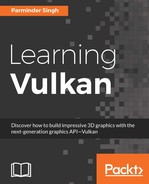- Learning Vulkan
- Learning Vulkan
- Credits
- About the Author
- Acknowledgments
- About the Reviewer
- www.PacktPub.com
- Preface
- 1. Getting Started with the NextGen 3D Graphics API
- 2. Your First Vulkan Pseudo Program
- Installing Vulkan
- The Hello World!!! pseudocode
- Initialization - a handshake with the device
- Swapchain initialization - querying the WSI extension
- Supplying shaders - shader compilation into SPIR-V
- Building layouts - descriptor and pipeline layouts
- Creating a Render Pass - defining a pass attribute
- Framebuffer - connect drawing images to the Render Pass
- Populating geometry - storing a vertex into GPU memory
- Pipeline state management - creating pipelines
- Executing the Render Pass - drawing Hello World!!!
- Queue submission and synchronization - sending jobs
- Displaying with presentation layer - rendering a triangle
- Fitting it all together
- Summary
- 3. Shaking Hands with the Device
- 4. Debugging in Vulkan
- 5. Command Buffer and Memory Management in Vulkan
- 6. Allocating Image Resources and Building a Swapchain with WSI
- Getting started with image resources
- Understanding image resources
- Memory allocation and binding image resources
- Introducing swapchains
- Understanding the swapchain implementation flow
- The swapchain implementation's class block diagram
- Renderer - a window management custom class
- VulkanSwapChain - the swapchain manager
- Creating the surface with WSI and associating it with the created window
- The graphics queue with present support
- Querying swapchain image formats
- Creating the swapchain
- Creating a depth image
- Summarizing the application flow
- Summary
- 7. Buffer Resource, Render Pass, Framebuffer, and Shaders with SPIR-V
- 8. Pipelines and Pipeline State Management
- Getting started with pipelines
- Caching pipeline objects with a PCO
- Creating a graphics pipeline
- Understanding compute pipelines
- Pipeline State Objects (PSO) in Vulkan
- Implementing the pipeline
- Summary
- 9. Drawing Objects
- Overview of the drawing process in Vulkan
- Preparing the drawing object
- Rendering the drawing object
- Rendering an indexed geometry
- Understanding synchronization primitives in Vulkan
- Resizing the display window
- Summary
- 10. Descriptors and Push Constant
- 11. Drawing Textures
- Image resource - a quick recap
- Prerequisites for texture drawing
- Implementing the image resource with linear tiling
- Implementing the image resource with optimal tiling
- Loading the image file
- Buffer object memory allocation and binding
- Populating the allocated device memory
- Creating the image object
- Image object memory allocation and binding
- Creating a command buffer object
- Setting the image layout
- Buffer to image copy
- Setting the optimal image layout
- Submitting the command buffer
- Creating an image sampler
- Creating the image view
- Copying data content between images and buffers
- Updating the descriptor set
- Summary
In this chapter, we rendered our first Hello World! program in Vulkan. Drawing it consists of two stages—preparation and rendering (execution). Preparation records the command buffers and the rendering executes them. The command buffers are recorded once and executed multiple times unless there is an explicit change in the pipeline state objects.
The preparation of the command buffer involves recording the Render Pass and graphics pipeline binding and drawing parameters, such as vertex buffers, viewport, scissor, and so on. Finally, the drawing API command is specified; we demonstrated both index- and nonindex-based drawing APIs using the sample application.
The recorded command buffer is executed in the rendering stage. The execution process acquires the swapchain image and submits the command buffer into the graphics queue. Painting is done on the acquired swapchain image. Once this is complete the image is sent to the presentation engine to be displayed on the output display. This chapter also demonstrated API commands for drawing indexed and non-indexed geometries. Towards the end of this chapter, we covered synchronization primitives in Vulkan and you learned how to perform synchronization in between the host and device, and queues and command buffers.
In the next chapter, we will learn about descriptors and the push constant, which allows the sharing of resource contents with the Shader program.
-
No Comment
